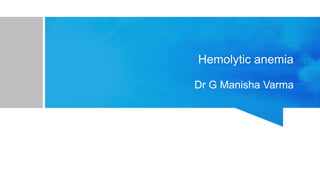The document provides an overview of hemolytic anemia, detailing its definitions, mechanisms (extravascular and intravascular), causes (both congenital and acquired), and related conditions. It discusses laboratory findings, complications, and management strategies, including specific clinical cases of autoimmune hemolytic anemia and sickle cell anemia, highlighting the importance of diagnosis and tailored treatment. Key tests and therapeutic approaches such as splenectomy, immunosuppressants, and stem cell transplant are also summarized.
























































